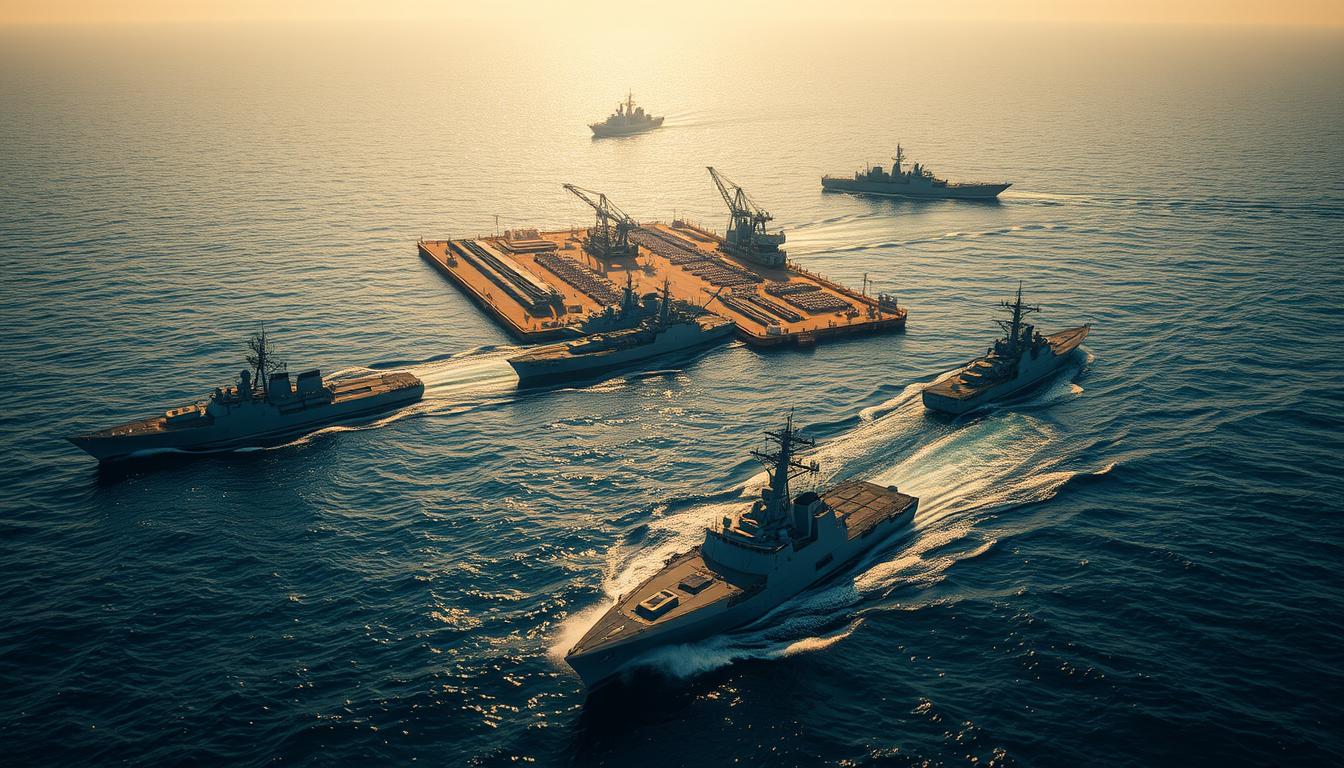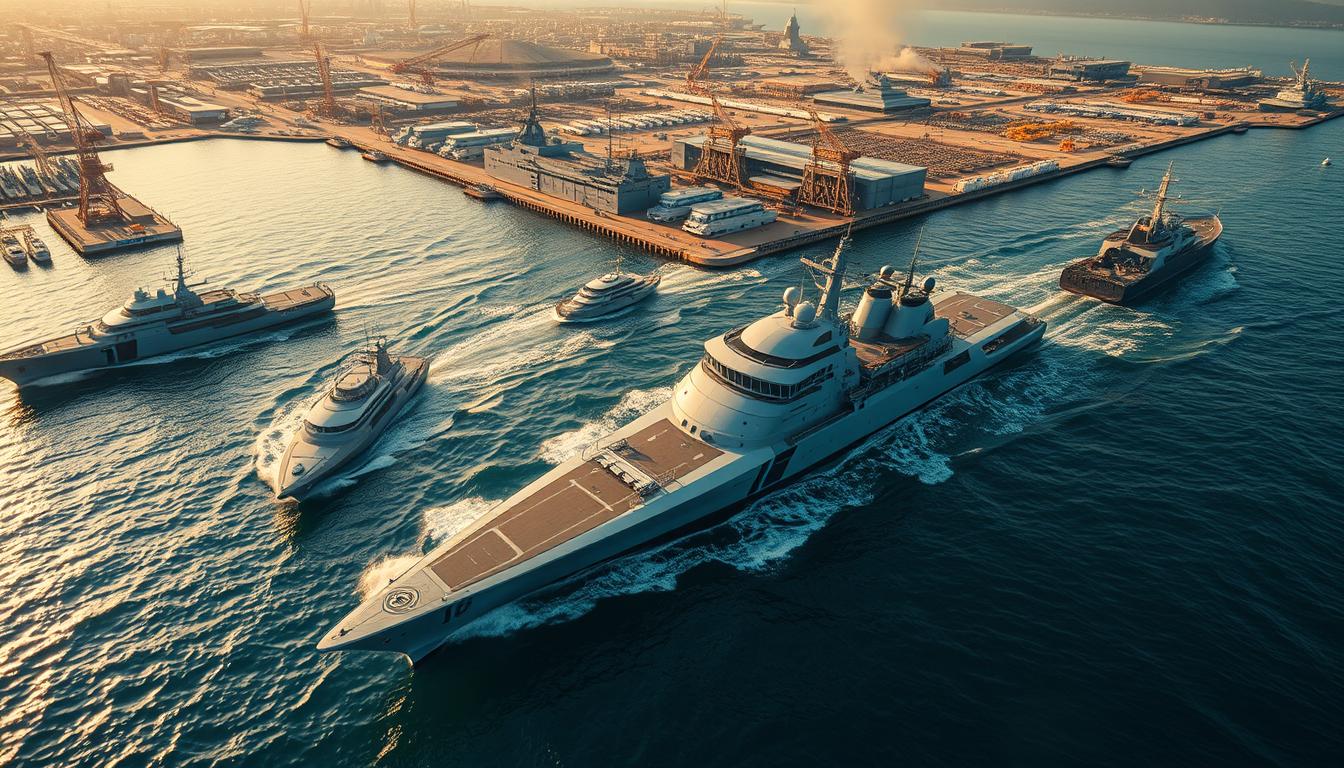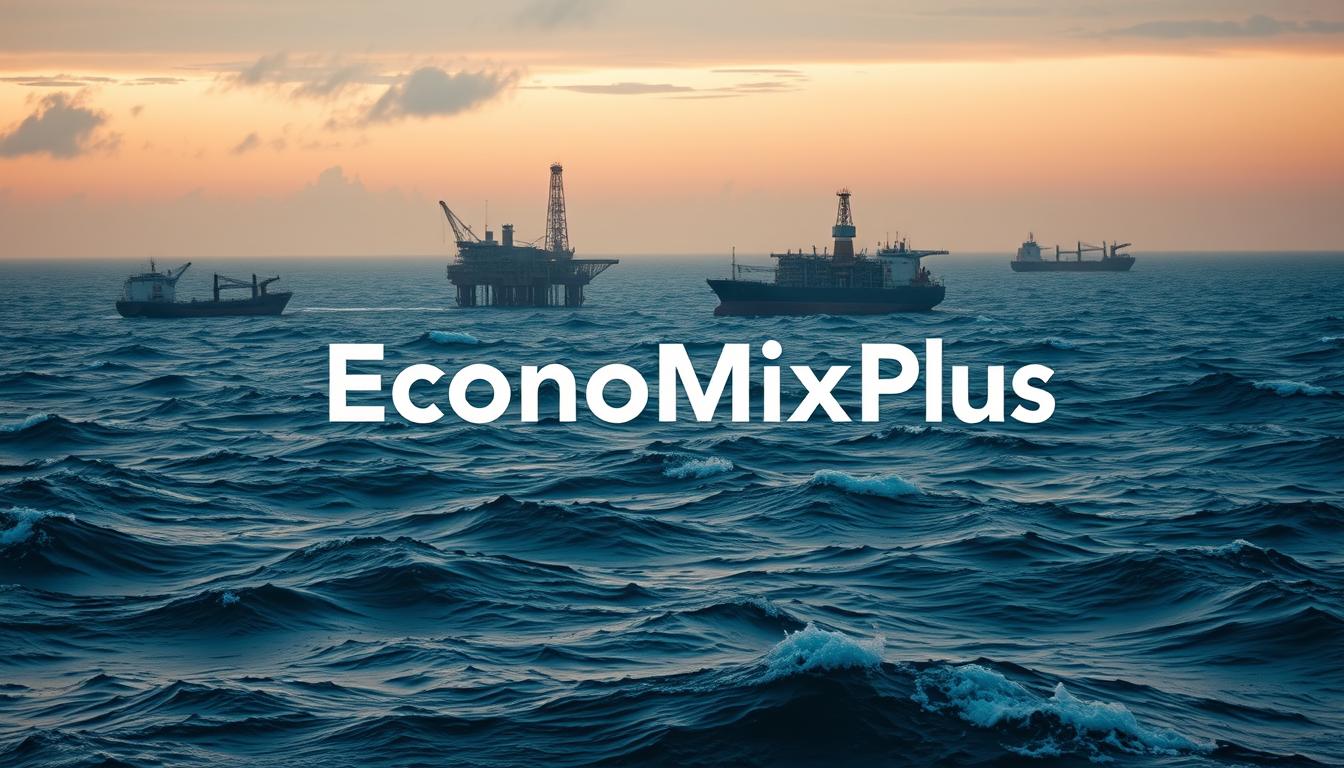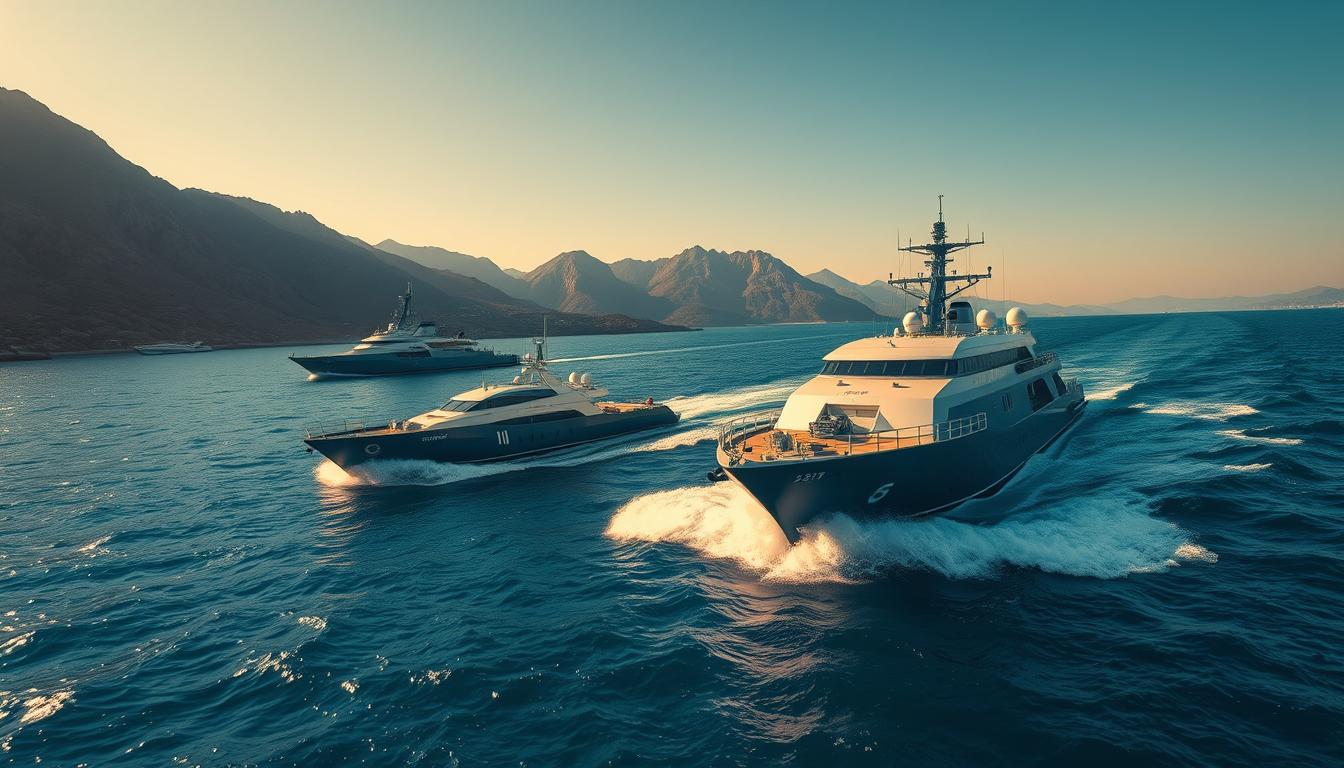What happens when a country pivots from relying on foreign naval technology to building its own warships, submarines, and even an aircraft carrier? The answer lies in Türkiye’s aggressive push to modernize its fleet, driven by a forward-defense strategy and the Blue Homeland doctrine. This vision prioritizes domestic shipbuilding to secure maritime borders and project influence across the eastern Mediterranean.
In early 2025, the nation’s defense ministry unveiled plans for 31 new warships. These include advanced submarines and air-defense destroyers designed locally. Such efforts aim to address historical gaps in naval capacity while countering regional security challenges. Cutting-edge engineering and homegrown systems now anchor this transformation.
The strategy isn’t just about hardware. It reflects a broader shift toward self-reliance, reducing dependence on external suppliers. Analysts note that this approach strengthens Türkiye’s ability to safeguard energy routes and assert territorial claims. The fleet expansion also signals a recalibration of power dynamics in a geopolitically volatile area.
Key Takeaways
- Türkiye plans to build 31 advanced warships by 2025, including an indigenous aircraft carrier.
- The Blue Homeland doctrine drives naval modernization to protect maritime interests.
- Domestic technology reduces reliance on foreign defense systems.
- New submarines and destroyers enhance power projection capabilities.
- Regional security concerns shape Türkiye’s forward-defense priorities.
Strategic Overview of Turkey’s Naval Expansion
Maritime dominance often begins with a simple question: Who controls the waves? For decades, Türkiye’s defense strategy focused on coastal protection, prioritizing the safeguarding of its territorial waters against external threats. Today, its vision spans contested waters from the Aegean to North Africa, reflecting a broader ambition to assert its influence in strategically significant maritime regions. This shift stems from historical tensions over maritime borders and access to offshore resources, as Türkiye seeks to navigate complex geopolitical landscapes that have long been fraught with conflict and competition.
From Doctrine to Deployment
Early 2000s policies laid groundwork for today’s ambitions. Diplomatic deals with Libya (2019) and Somalia (2024) expanded exclusive economic zones, cementing claims. Analysts note these moves reflect a pattern: securing energy routes while countering rival claims. Past disputes with Greece over islands and drilling rights further accelerated naval modernization.
Sea Power Meets Resource Politics
The eastern Mediterranean holds vast natural gas reserves. Türkiye’s fleet upgrades aim to:
- Protect exploration activities in disputed areas
- Deter foreign military interventions
- Enable rapid response to regional crises
Unmanned surface vessels now patrol key corridors, complementing new destroyers. This blend of diplomatic agility and homegrown tech reduces reliance on imports. As one defense expert observed, “Control underwater cables and gas fields, and you control the region’s future.”
Turkey’s Naval Shipbuilding and Power Shifts in the Eastern Mediterranean
The race for underwater resources is reshaping naval priorities in contested waters. Türkiye’s defense strategy now merges cutting-edge shipbuilding with bold bilateral agreements to secure energy-rich zones. A 2024 deal with Somalia expanded its exclusive economic zone by 30%, directly challenging rival claims from other countries. This expansion not only enhances Türkiye’s control over critical maritime areas but also reflects a broader ambition to assert its influence in the eastern Mediterranean, where energy competition is intensifying.
The strategic partnerships formed through such agreements are vital for ensuring access to lucrative hydrocarbon reserves, which are becoming increasingly contested. Moreover, these initiatives serve to bolster Türkiye’s regional standing and deter potential adversaries, signaling a commitment to protect its national interests in the face of growing external pressures.
New destroyers and submarines equipped with domestically developed systems form the backbone of this push. “Our vessels aren’t just tools of defense—they’re instruments of sovereignty,” states a recent Defense Ministry report. These platforms enable rapid responses to drilling disputes while safeguarding the country’s southern coast.
Three key elements define this approach:
- Strategic maritime boundary agreements to counter claims by adjacent countries
- Advanced patrol capabilities along vital hydrocarbon routes
- Integration of resource exploration rights into security policy
Such measures counterbalance pressures from regional and competing countries seeking to limit access to offshore resources. These diplomatic agreements, combined with naval innovation, anchor Türkiye’s claims in both law and capability. The result? A transformation where energy security and territorial control become inseparable along critical coasts.
Evolution of the Blue Homeland Doctrine
Maritime strategies often emerge from contested waters. The Blue Homeland doctrine, first outlined by retired Admiral Cem Gürdeniz in 2006, redefined the nation’s approach to maritime sovereignty. It asserts control over 462,000 km² of waters—a claim rooted in historical treaties and UNCLOS interpretations. This doctrine not only emphasizes the importance of national interests in maritime affairs but also highlights the strategic necessity of safeguarding maritime boundaries against external threats.
By asserting these rights, Türkiye aims to secure vital resources and enhance its geopolitical standing in a region marked by competing claims and tensions. The Blue Homeland doctrine serves as a framework for navigating these complexities, reinforcing the country’s commitment to protecting its maritime territories and ensuring access to crucial energy reserves.

From Theory to National Strategy
Initially dismissed as aspirational, the doctrine gained traction after 2010. Energy discoveries in the eastern Mediterranean transformed it into actionable policy. By 2019, bilateral deals with Libya formalized exclusive economic zones, directly challenging rival claims to natural gas reserves.
Policy Meets Naval Innovation
This vision reshaped shipbuilding priorities. Domestic firms now design multirole corvettes and drones optimized for prolonged patrols. “Our ships must enforce sovereignty while securing resources,” a naval architect noted in 2023. The approach balances coastal defense systems with deep-water capabilities.
Recent fleet upgrades reflect this duality. New destroyers integrate missile defense for traditional threats, while advanced sonar maps untapped natural gas fields. Such innovations anchor the doctrine’s central premise: maritime power stems from both legal claims and technical superiority.
Critics argue the strategy risks overextension. Yet its influence persists, driving 78% of recent naval contracts toward vessels supporting resource exploration. As regional energy disputes intensify, the Blue Homeland framework continues steering policy debates—and shipyard blueprints.
Key Naval Projects: MUGEM, TF-2000, and MILDEN
The future of maritime defense hinges on blending stealth, firepower, and electronic intelligence. Three flagship initiatives—MUGEM, TF-2000, and MILDEN—embody this fusion of innovation and strategy. Each platform addresses distinct operational needs while reinforcing broader security objectives.
Technological Capabilities and Strategic Objectives
The MUGEM aircraft carrier represents a leap in domestic engineering. Its hybrid propulsion system enables extended patrols, allowing for a significant increase in operational range and endurance. This advanced technology not only enhances fuel efficiency but also reduces the carrier’s acoustic signature, making it harder to detect. Furthermore, an electromagnetic catapult launches drones and fixed-wing aircraft with precision and speed, ensuring rapid deployment in various scenarios.
Designed to operate 30+ unmanned vehicles, it extends surveillance across contested gas fields, providing a strategic advantage in monitoring and securing vital maritime resources. This capability is particularly crucial as tensions rise in energy-rich regions, enabling the MUGEM to act as a formidable platform for both defense and deterrence.

TF-2000 destroyers focus on layered defense. Their 96-cell vertical launch system (VLS) fires indigenous missiles at ranges exceeding 150 km. Integrated radar networks track 1,200 targets simultaneously—a critical edge in crowded maritime zones. “This isn’t just a ship; it’s a mobile command center,” notes a defense analyst.
MILDEN submarines shift the stealth paradigm. Air-independent propulsion (AIP) allows 18-day submerged operations. Advanced SIGINT systems intercept communications, providing real-time intelligence during covert missions.
Project Timelines and Anticipated Operational Benefits
| Project | Key Features | Operational Date |
|---|---|---|
| MUGEM | Drone carrier, 45,000-ton displacement | 2029 |
| TF-2000 | 96-cell VLS, 150+ km missile range | 2027 |
| MILDEN | AIP, SIGINT suite, 6 torpedo tubes | 2030 |
These platforms will reshape regional dynamics. MUGEM’s drone swarms secure offshore gas infrastructure, while TF-2000 shields allied ships during joint operations. MILDEN’s reconnaissance capabilities deter unauthorized resource exploration.
Though complex, these projects prioritize defensive modernization over offensive assault capabilities. Their phased deployment through 2030 aims to solidify the navy’s role as a guardian of maritime sovereignty and regional stability.
Technological Innovations in Turkish Naval Capabilities
Advanced technology now dictates who controls contested waters. The country’s naval forces are deploying fifth-generation warfare systems, blending unmanned platforms with next-gen sensors to dominate maritime theaters. These systems are designed to enhance situational awareness and operational effectiveness, allowing for swift responses to emerging threats in complex environments.
Domestic engineering breakthroughs have enabled this leap, reducing foreign dependencies while enhancing strategic flexibility. This shift not only bolsters national security but also fosters innovation within the defense industry, creating a robust ecosystem that supports ongoing research and development. As a result, Turkey is positioning itself as a key player in the evolving landscape of naval warfare, leveraging its technological advancements to secure its maritime interests.

Integration of Unmanned Systems and Advanced Radar Technologies
Unmanned combat aerial vehicles (UCAVs) like the Bayraktar TB3 now operate from warships, scanning 500 km radii for threats. These drones work alongside ÇAFRAD radar networks, which detect stealth aircraft at unprecedented ranges. “Our systems see farther and react faster,” states a defense official. This synergy allows real-time targeting in crowded waters.
Local Production and Engineering Excellence
Domestic firms design 85% of critical naval components, from propulsion to encrypted comms. The TF-2000 destroyer exemplifies this shift—its phased-array radar was entirely developed locally. Such projects cut procurement timelines by 40% while fostering technical expertise. Engineers now test submarine-launched cruise missiles capable of striking land targets.
These innovations address regional tensions through deterrence rather than escalation. By mastering cutting-edge systems, naval forces secure energy routes while asserting sovereignty over disputed zones. As one analyst notes, “Superior tech isn’t just part of the strategy—it is the strategy.”
Energy Geopolitics and Maritime Resource Exploration
Energy reserves beneath the waves are rewriting regional power equations. Massive hydrocarbon discoveries in contested waters have transformed maritime boundaries into economic battlegrounds. The state has intensified its efforts to secure sovereign rights over these resources through strategic alliances and legal frameworks, which are part of a broader policy context involving the Turkish navy and relations with neighboring states.

Fueling Sovereignty Through Resource Control
Recent natural gas finds sparked a rush to formalize exclusive exploration zones. Bilateral accords with Libya (2019) and Somalia (2024) exemplify this project, extending jurisdictional claims by 462,000 km². “Energy corridors define modern sovereignty,” remarks a geopolitical analyst. These deals counterbalance rival attempts to isolate the nation from resource-rich seabeds.
Three strategic priorities anchor these efforts:
- Leveraging UNCLOS provisions to legitimize maritime claims
- Deploying naval assets to protect drilling operations
- Forging allies through shared energy infrastructure projects
Defense planners now integrate energy security into fleet modernization programs. New destroyers patrol gas fields while drones monitor underwater pipelines. This fusion of military and economic objectives reshapes regional alliances, drawing partners seeking alternative energy suppliers.
Critics argue such moves heighten tensions. Yet in the context of Europe’s energy crisis, these efforts position the nation as a potential supplier to Western allies. As offshore drilling accelerates, maritime law and naval power jointly script the next chapter of Mediterranean geopolitics.
Regional Power Competition and Strategic Diplomacy
How do nations assert influence in contested waters without triggering open conflict? The answer lies in a calibrated mix of military modernization and diplomatic agility. Recent years have seen intensified competition over energy-rich maritime zones, driving both confrontation and unexpected partnerships.
Interactions with Greece, Cyprus, and Regional Actors
Tensions with Greece over airspace violations and island militarization remain high. Yet bilateral communication channels stay active. In 2023, joint search-and-rescue drills demonstrated how cooperation can coexist with rivalry. “We manage crises through dialogue, not dogma,” remarked a senior defense official.
Cyprus presents a more complex challenge. Disputed drilling rights in the Aphrodite gas field have led to naval standoffs. Ankara counters by deepening energy ties with Northern Cyprus while expanding its fleet’s patrol presence. This dual approach balances legal arguments with visible deterrence.
| Country | Diplomatic Strategy | Outcome |
|---|---|---|
| Greece | De-escalation talks + parallel military upgrades | Reduced mid-air incidents since 2022 |
| Cyprus | Resource-sharing proposals with Turkish Cypriots | Partial exploration rights secured |
| Egypt | Joint naval exercises in 2024 | Improved intelligence-sharing on migrant routes |
The growing fleet serves as both shield and bargaining chip. During 2024 gas negotiations, destroyer deployments near the Levant Basin underscored resolve. Yet behind closed doors, diplomats proposed joint resource management frameworks—a tactic blending strength with pragmatism.
Regional cooperation initiatives reveal this balance. Multinational anti-piracy missions showcase collective security efforts, while exclusive drilling contracts with Libya assert unilateral interests. Such maneuvers prove that in the Mediterranean’s crowded strategic field, sustainable presence requires equal parts steel and statecraft.
Turkey’s Foreign Policy Activism and Global Implications
Diplomatic maneuvers in contested waters are reshaping global alliances. Recent maritime boundary agreements with Libya and Somalia exemplify Türkiye’s strategy to legitimize claims over energy-rich zones. These deals extend jurisdiction across 490,000 km² of the Mediterranean and Red Sea, altering competition dynamics among coastal states.
Diplomatic Initiatives and Maritime Boundary Agreements
Three pillars define this approach:
- Securing exclusive rights to offshore hydrocarbon reserves
- Countering rival claims through UNCLOS-compliant accords
- Leveraging naval construction projects to enforce sovereignty
The size of Türkiye’s fleet has grown 22% since 2020, with destroyers now patrolling disputed corridors. Advanced drones monitor gas exploration sites, deterring unauthorized activities. “Control the sea, and you shape regional stability,” notes a NATO-affiliated analyst.
These efforts recalibrate global security frameworks. Partnerships with non-Western states challenge traditional energy supply chains while expanding Türkiye’s role as a maritime mediator. As competition intensifies over undersea reserves, diplomatic agility and naval modernization remain inseparable tools of statecraft.
Analysis of Naval Developments in the Black Sea and Eastern Mediterranean
How does a nation balance cooperative security in one theater while asserting dominance in another? Recent naval developments reveal stark contrasts between Türkiye’s approaches to the Black Sea and Eastern Mediterranean. In the former, joint exercises with neighbors like Romania underscore collaborative security efforts. In the latter, assertive boundary agreements and drills signal a more unilateral posture.
Comparative Strategic Opportunities in Both Regions
The Black Sea offers opportunities for NATO-aligned partnerships. Joint mine-countermeasure drills in 2023 improved interoperability with regional allies. Contrast this with the Eastern Mediterranean, where recent years saw Türkiye deploy advanced frigates near Cyprus following gas exploration disputes. This duality reflects tailored strategies: fostering stability in one area while challenging rivals in another.
Implications for Regional Stability and U.S. Security Interests
Washington views Black Sea cooperation as vital for countering Russian influence. However, Türkiye’s Eastern Mediterranean maneuvers complicate U.S. efforts to balance alliances with Greece and Cyprus. A 2024 naval standoff near Crete highlighted these tensions, prompting calls for diplomatic de-escalation.
Three trends define the evolving role of Türkiye’s naval power:
- Prioritizing energy corridor defense in contested zones
- Expanding drone-based surveillance across both seas
- Leveraging shipbuilding advances to project influence
These developments underscore how regional conflict dynamics shape global security frameworks. As Türkiye strengthens its maritime posture, its dual-track strategy tests traditional alliances while redefining its role in a multipolar world.
Conclusion
Strategic autonomy in maritime defense is no longer an aspiration but a tangible reality for regional actors. The Blue Homeland doctrine remains central to this transformation, merging territorial claims with cutting-edge naval development. By prioritizing domestic warship production and advanced systems like the amphibious assault ship, the nation reinforces its capacity to secure energy corridors and maritime borders.
Recent activities highlight three critical shifts: rapid fleet modernization, expanded patrol capabilities, and diplomatic frameworks supporting resource exploration. Projects like TF-2000 destroyers and MILDEN submarines underscore a commitment to self-reliance, while bilateral agreements solidify claims in the sea eastern Mediterranean.
These developments reshape regional power balances, blending military readiness with energy geopolitics. As drone patrols and destroyer deployments become routine, the Blue Homeland doctrine evolves from theory to operational doctrine. This approach not only counters external pressures but positions the navy as a guarantor of stability amid contested waters.
Looking ahead, defense activities will likely focus on integrating new technologies with alliance-building efforts. The sea eastern Mediterranean remains a testing ground for sovereignty assertions, where legal frameworks and naval might intersect. Through sustained innovation and strategic partnerships, regional actors aim to secure their interests in an increasingly multipolar maritime landscape.















Post Comment